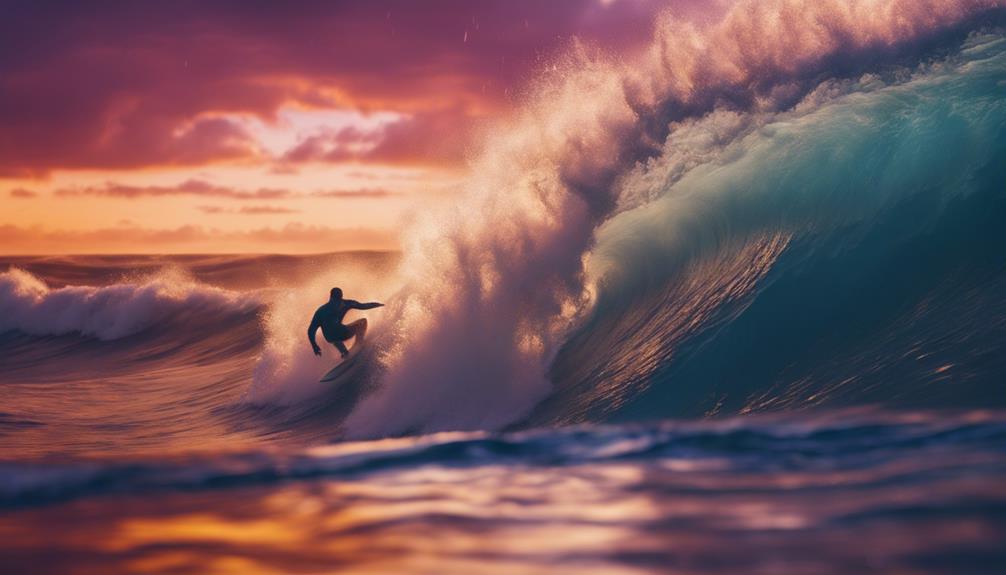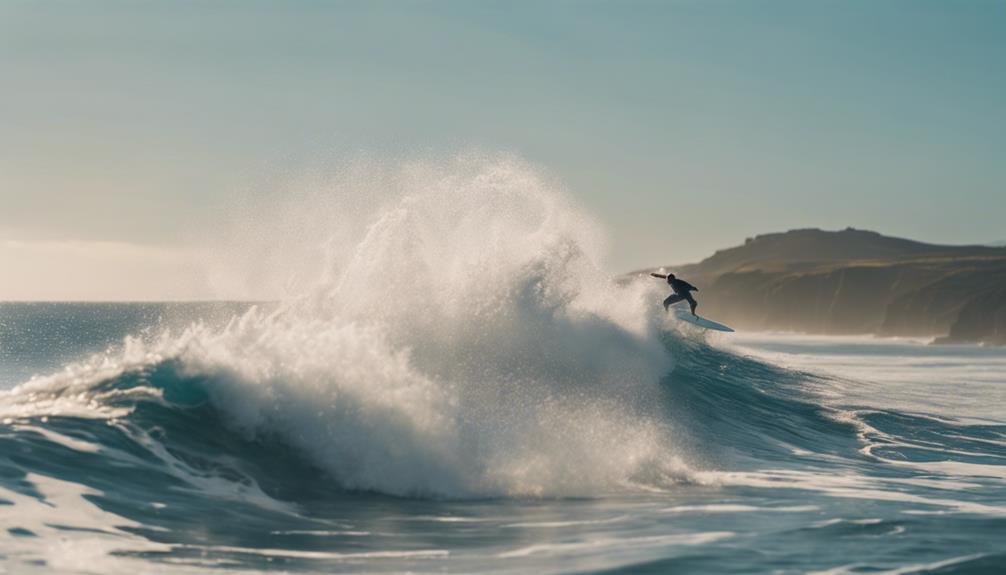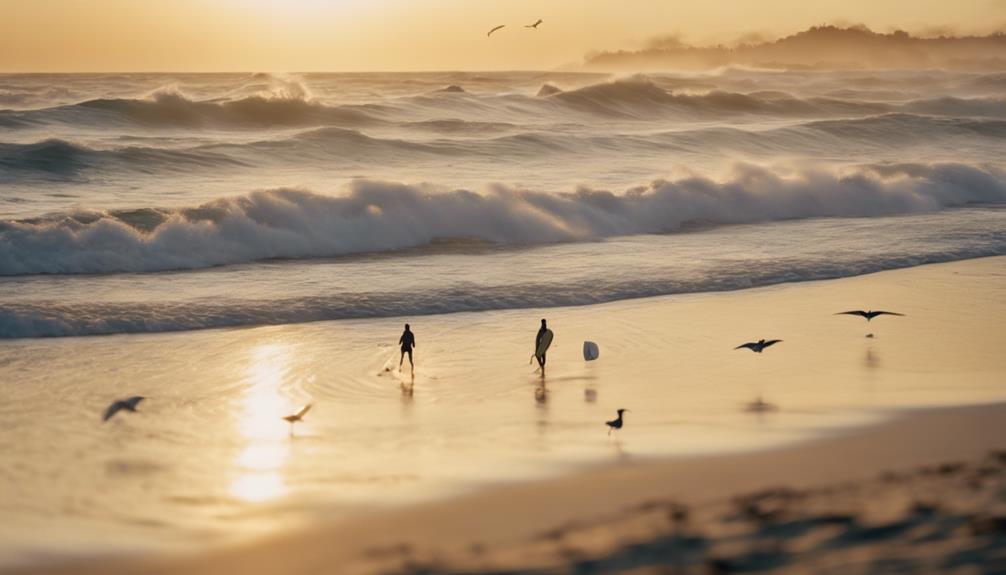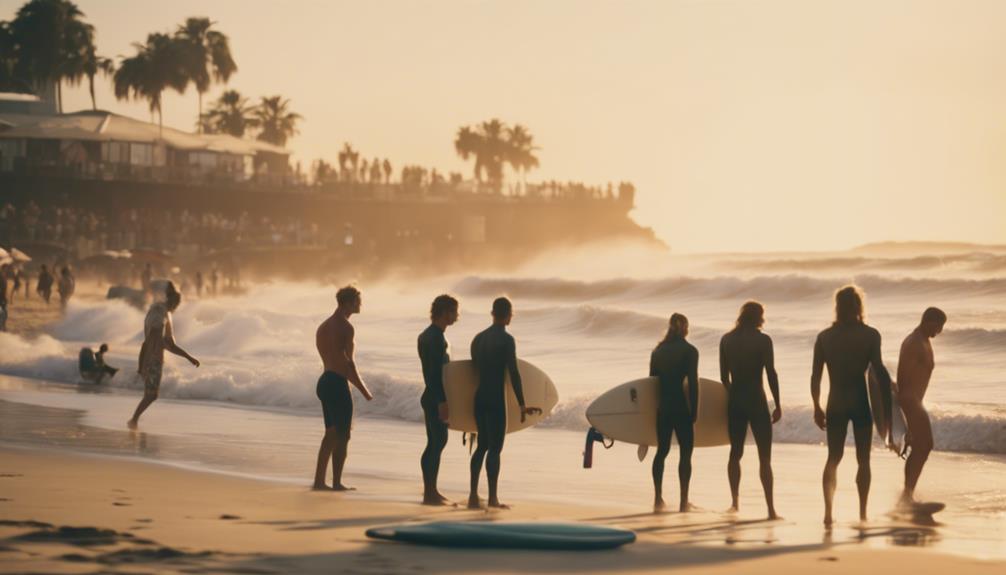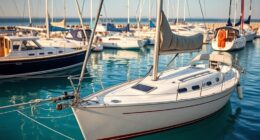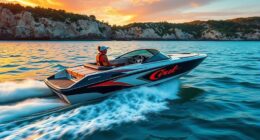If you're looking for the biggest surfing waves, you've got to check out Mavericks in California and Nazaré in Portugal. These spots are infamous for swells that can reach heights of up to 60 feet and record-breaking waves over 80 feet. Jaws in Hawaii and Teahupoo in Tahiti also boast massive waves that test even the most skilled surfers. Riding these titanic swells requires not only skill but also a strong understanding of safety measures and ocean conditions. There's so much more to explore about these epic waves and the surfers who chase them.
Key Takeaways
- Big wave surfing is defined as riding waves over 20 feet, with notable locations like Mavericks, Nazaré, and Jaws.
- Nazaré, Portugal, holds record-breaking waves, reaching heights of 26.2 meters, attracting surfers globally.
- Mavericks in California features waves up to 60 feet and is known for its challenging conditions and great white sharks.
- Jaws (Peahi) in Hawaii offers waves ranging from 30 to 80 feet, making it a premier destination for big wave surfers.
Overview of Big Wave Surfing
Have you ever wondered what it takes to ride the massive waves of big wave surfing, defined by their towering heights of over 20 feet? This exhilarating sport captivates surfers and spectators alike, with iconic locations like Mavericks in California and Nazaré in Portugal serving as hotspots for big waves that can soar to astonishing heights.
The history of big wave surfing dates back to the 1950s and 1960s, when advancements in surfboard technology and increased media exposure brought this extreme sport into the limelight.
For big wave surfers, safety in big wave surfing is critical. Riders rely on jet skis for quick rescues and spotters to monitor conditions, ensuring that they can navigate these colossal waves with as little risk as possible.
Surfers like Laird Hamilton and Garrett McNamara haven't only achieved record-breaking rides but have also inspired a global culture around big wave surfing. By mastering the art of tackling these enormous swells, they push the limits of what's possible in the surfing world, making every ride a demonstration of skill, bravery, and the raw power of nature.
Historical Context and Evolution
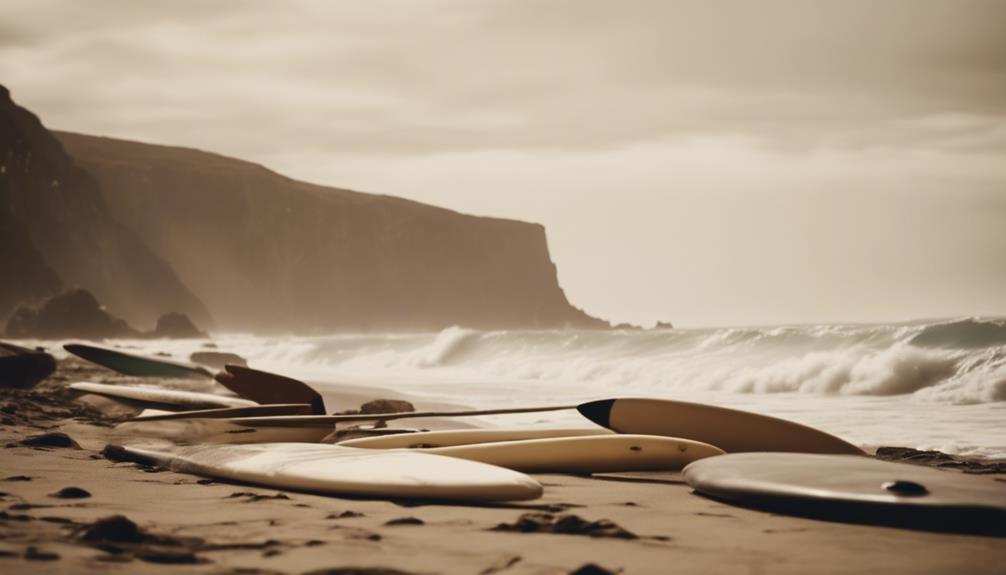
Big wave surfing has evolved considerably since its roots in ancient Polynesian culture, transforming into a recognized competitive sport over the decades. The sport gained prominence in the 1950s and 1960s, fueled by innovations in surfboard design that enhanced performance and safety.
Today, big-wave surfers from around the globe, including Australia, Brazil, and South Africa, participate in this thrilling sport. The World Surf League (WSL) established its first big wave title in 2009, marking a significant milestone in professional recognition.
| Era/Development | Key Features |
|---|---|
| Ancient Polynesia | Early roots of surfing |
| 1950s-1960s | Rise in popularity, surfboard innovations |
| Early 2000s | Introduction of Tow-in surfing |
As the sport evolves, techniques vary. While Tow-in surfing made it easier to ride larger Mavericks waves, many purists are embracing traditional paddling methods once again. Understanding this historical context enriches your appreciation for the evolution of big wave surfing and its current status as an exhilarating and competitive discipline.
Notable Big Wave Locations
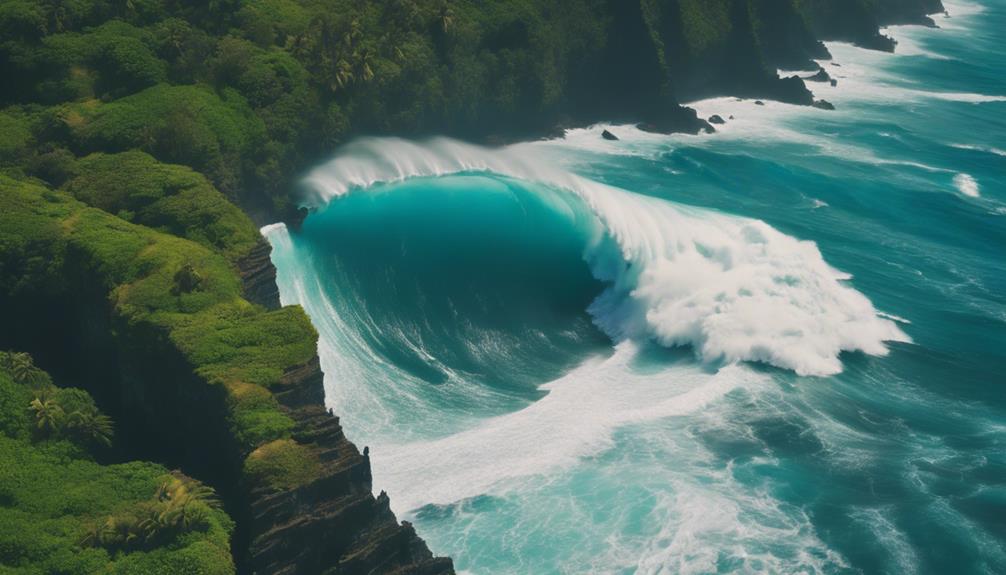
The rich history of big wave surfing sets the stage for exploring some of the most notable locations where these massive swells attract surfers from around the world.
Mavericks in California is infamous for its towering waves, reaching up to 60 feet, and it's also known for its great white shark population. If you're looking for record-breaking waves, Nazaré in Portugal is the place to be, with Garrett McNamara and Sebastian Steudtner making waves in history with their rides of 23.8 and 26.2 meters, respectively.
Over in Hawaii, Jaws (Peahi) offers an exhilarating experience with waves ranging from 30 to 80 feet, drawing elite big wave surfers enthusiastic to tackle its unpredictable conditions.
Teahupoo in Tahiti, known as the world's heaviest wave, hosts the prestigious Billabong Pro Tahiti competition each year, showcasing some of the best talent in the sport.
Puerto Escondido, dubbed the Mexican Pipeline, features powerful waves that can reach up to 16 meters, making it a hotspot during competition season for surfers seeking thrilling challenges.
Training and Safety Measures
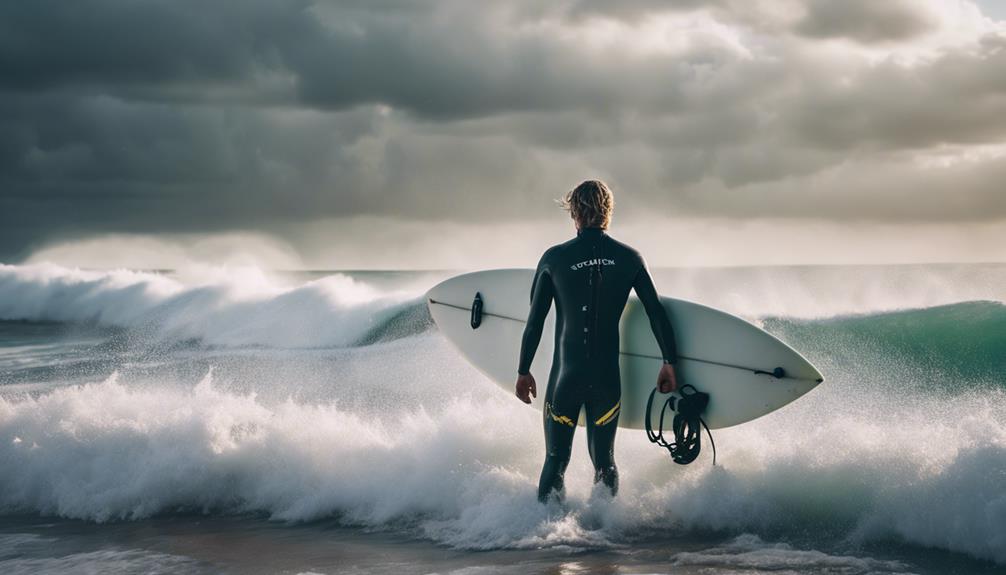
Training for big wave surfing demands not just physical fitness but also mental resilience, as you face the ocean's immense power head-on.
To prepare, you should start with regular practice in smaller waves, which helps build the foundational skills necessary for tackling those giant swells. This solid groundwork equips you to handle the increased difficulty and risks involved.
In addition to honing your skills, investing in proper safety gear is essential. Equip yourself with impact vests, helmets, and flotation devices to protect against wipeouts and potential injuries in high-risk conditions.
Understanding ocean hazards, like rip currents and underwater topography, is critical as well; it helps you make informed decisions while surfing.
During your sessions, always prioritize safety. Jet skis play a significant role in rescue operations, providing quick access to surfers in distress.
Additionally, having spotters and safety teams present during competitions adds an extra layer of security.
Famous Big Wave Surfers
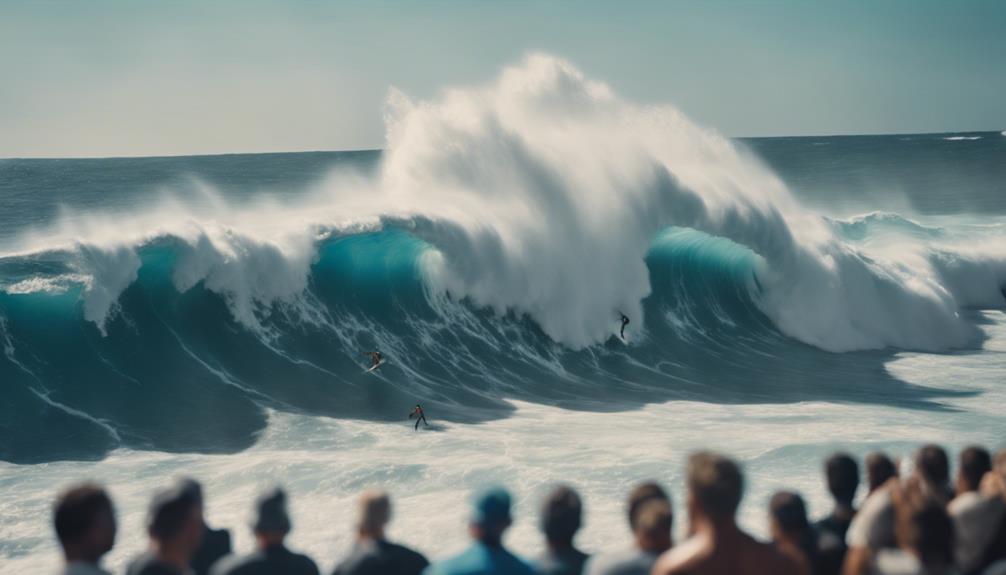
When you think about famous big wave surfers, several names stand out for their incredible feats and contributions to the sport.
You'll discover not only legendary male surfers like Laird Hamilton and Garrett McNamara, but also trailblazing women like Bethany Hamilton and Justine Dupont, who are making waves in a traditionally male-dominated arena.
Let's explore their remarkable stories and impact on big wave surfing.
Notable Surfers Overview
Notable big wave surfers like Laird Hamilton and Garrett McNamara have pushed the boundaries of the sport, showcasing incredible skill and courage in the face of monstrous waves. Laird, known for pioneering tow-in surfing, often tackles waves exceeding 50 feet, redefining what's possible in big wave riding. Garrett made headlines by riding a record-breaking 78-foot wave at Nazaré, later surfacing on an astonishing 86-foot wave, cementing his status in the big wave community.
Kelly Slater, a multiple world champion, has also made significant contributions to big wave surfing. His versatility shines through as he excels in various surf conditions, including the notorious waves at Mavericks.
Then there's Bethany Hamilton, who, despite facing adversity after a shark attack, continues to inspire and compete fiercely in big wave events, promoting inclusivity in the sport.
Justine Dupont stands out as a leading female big wave surfer, recognized for her achievements in challenging conditions. She's among the first women to surf massive waves at iconic locations like Nazaré and Teahupoo, further showcasing the evolution and growth of big wave surfing.
These surfers exemplify the spirit and thrill of riding the world's biggest waves.
Women in Big Wave Surfing
The rise of women in big wave surfing has brought incredible talent and determination to the forefront, showcasing athletes like Justine Dupont and Bethany Hamilton who are breaking records and inspiring future generations.
Justine Dupont, for instance, made history in 2020 by riding a 35.5-foot wave at Nazaré, earning the Women's Best Overall Performance at the World Surf League Big Wave Awards. This achievement highlights the skill and tenacity women bring to this demanding sport.
In 2018, the inclusion of female surfers in the Titans of Mavericks competition marked a significant milestone for gender equality in big wave surfing. For the first time, women received equal prize money, demonstrating the growing recognition of their contributions to surf competition.
Izzi Gomez, a five-time stand-up paddle surfing champion, is actively pursuing titles in big wave surfing, further showcasing the increasing participation of women in this arena.
The visibility of these athletes not only empowers them but also inspires countless girls to chase their dreams in the surf. As more women take to the waves, the future of big wave surfing looks brighter than ever.
Environmental and Cultural Impact

Big wave surfing destinations like Nazaré and Mavericks energize local economies by attracting surfers and spectators, creating a vibrant surf tourism scene that benefits coastal communities. This influx of visitors not only boosts local businesses but also fosters a deep connection to the ocean.
However, as you enjoy these epic waves, remember the significance of environmental health.
Consider these impacts:
- Pollution threatens marine ecosystems, affecting wave quality.
- Climate change alters surf conditions, jeopardizing surf tourism.
- Community engagement in ocean conservation is essential for sustainability.
- Surf culture emphasizes respect for nature and inclusivity.
Frequently Asked Questions
Where Are the Biggest Waves to Surf?
You'll find the biggest surfable waves at Nazaré, Portugal, Jaws in Maui, Mavericks in California, Teahupoo in Tahiti, and Cortes Bank off Southern California. Each spot offers unique challenges for adventurous surfers like you.
Has Anyone Surfed a 100-Foot Wave?
No one's conquered a 100-foot wave yet, but it's just a heartbeat away. You've got legends like Sebastian Steudtner riding near-record waves, proving that the quest for greatness in surfing is alive and thrilling.
Why Are Nazaré Portugal Waves so Big?
Nazaré's waves are massive due to its unique underwater canyon, which funnels swells, combined with powerful North Atlantic storms. These conditions create consistent, giant waves, especially between November and March, making it a big wave surfing hotspot.
What Was the Biggest Wave at Cortes Bank?
You might think Cortes Bank's biggest wave is just a myth, but it reached an astounding 80 feet. Surfers brave the dangerous waters, drawn by the thrill of conquering nature's most powerful swells.
What Makes Irish Surfing Waves Comparable to the Titans of Surf Worldwide?
When it comes to surfing, the biggest surfing waves ireland are truly comparable to the titans of surf worldwide. With its rugged coastline and powerful Atlantic swells, Ireland offers some of the most challenging and thrilling waves for surfers. The combination of stunning scenery and epic waves makes Irish surfing truly world-class.
Conclusion
Big wave surfing isn't just a sport; it's a thrilling demonstration of human courage and connection with nature.
As you watch these titans ride colossal waves, you can't help but wonder: what drives them to face such immense power?
Their passion fuels the culture surrounding big wave surfing, inspiring awe and respect for both the ocean and those who dare to challenge it.
So, whether you're a surfer or a spectator, embrace the spirit of adventure and the ocean's untamed beauty.

